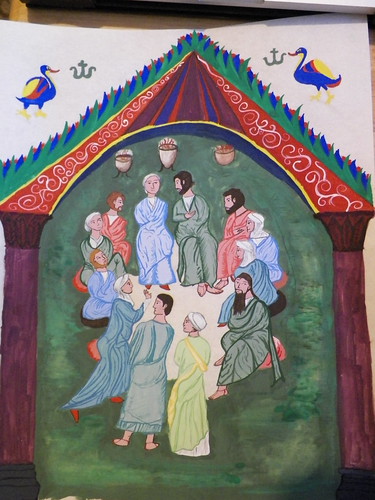To be fair, my Laurel did lay down a couple expectations about doing something a bit more . . . involved . . . than my last few swaps.

So I did do something really out of my comfort zone in a lot of ways. I did go with some things that were comfortable to me (check out the veil pins!), but I also did the paternoster that you see to your right.
This paternoster used a couple of lampworking techniques that I'm still learning (like playing with making my own stringers and very basic canes - the flowers used twisties and filigrana that I made myself!), and I also worked on a more consistent bead shape.
If you look at the detail of the purple gaud bead, you can (faintly) see the yellow filigrana I used. Filigrana is a technique where an opaque rod of glass is encased in clear glass and then pulled. A twistie is exactly what it sounds like - two colours of glass twisted together. The centre of the flowers used a twistie of colours. As for the details of the flowers - little dots using a very fine stringer. The bigger portions of the flower (inspired by my recipient's love of forget-me-nots) were dots from a rod. I'm proud of this, as the blue beads are relatively consistent in shape, size, and texture, and the flowers, while being rustic, are definitely flowers. The only bits I did not actually make for the paternoster were the silver ring (which was from a box of beads a friend gave me), the commercially made metal spacer beads, and the silk for the tassel.
In addition to the paternoster, my recipient also wore veils, and in order to wear veils properly, every good woman needs veil pins. These were at times problematic. I used brass, both as it is inexpensive, and because the Romans used a copper alloy (check out the link and the Roman digs). Brass is usually comprised of an alloy of copper and tin, so it would make some sense that the Romans' copper alloy would be similar to brass. Unfortunately brass causes glass to bubble and react, and while it can look really interesting, it can cause some issues. I had to redo one pin partially because my torch melted the brass slightly, and two because the bubbles from the brass touching the glass caused the glass head to break, so it was back to the torch to redo another. (sort of a "things you learn from experimenting.") All in all, my recipient was very happy, and I was quite satisfied.
And then I received the coolest little enameled medallion based on a Byzantine medallion. It was a great swap, and I definitely want to do another, but I have to look at Queen's Prize. Something tells me it may be awesomely Roman.


